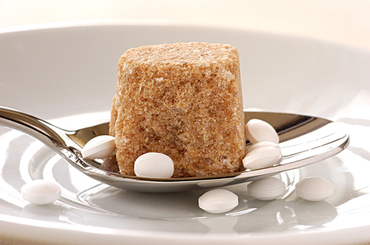Artificial sweeteners

Artificial sweeteners are synthetic sugar substitutes. They are high-intensity sweeteners, that is, sweeteners that are many times sweeter than ordinary sugar. They do not contribute to tooth decay and they have a negligible number of calories. Examples include aspartame (used, for example, in the brands of NutraSweet and Canderel), saccharin (used, for example, in the brand Sweet’N Low) and sucralose (used, for example, in the brands of Splenda and Canderel Yellow).
Artificial sweeteners have been popular among people wanting to lose weight. They have also been used by some diabetics to help to limit their sugar intake and thereby control their blood sugar levels. The food industry has favoured artificial sweeteners because their shelf-life is long and smaller quantities are needed in comparison with ordinary sugar. Both of these factors make it cheap to use.
There are ongoing debates about whether the use of artificial sweeteners is a risk for health. While the government guidelines in numerous countries do not consider them to be a health risk, provided the acceptable daily intake is not exceeded, there are some studies that suggest they may be.
If you’re interested in these debates, you can find more information, for example, by searching the database of the US National Library of Medicine, National Institutes of Health or by doing a more general online search. This way you can make an informed choice about whether you want to use artificial sweeteners or not.
The recipes on this website and in my book No Naughties: Sweet treats without sugar, wheat, gluten and yeast do not use any artificial sweeteners. Instead, xylitol, Sweet Freedom, no-added-sugar fruit spreads and natural sweetness from fresh and dried fruit are used.
Copyright © Tarja Moles 2012. Photograph © Food-micro | Dreamstime.com. All rights reserved.
If you’d like to use this article in your ezine or on your website, you’re welcome to do so as long as you use the complete article, including the copyright line, and include the following paragraph in its entirety:
Tarja Moles is the author of No Naughties: Sweet Treats without Sugar, Wheat, Gluten and Yeast. Visit www.nonaughties.com for free recipes and information on special diets and living with multiple dietary restrictions.
Back to Articles
Artificial sweeteners have been popular among people wanting to lose weight. They have also been used by some diabetics to help to limit their sugar intake and thereby control their blood sugar levels. The food industry has favoured artificial sweeteners because their shelf-life is long and smaller quantities are needed in comparison with ordinary sugar. Both of these factors make it cheap to use.
There are ongoing debates about whether the use of artificial sweeteners is a risk for health. While the government guidelines in numerous countries do not consider them to be a health risk, provided the acceptable daily intake is not exceeded, there are some studies that suggest they may be.
If you’re interested in these debates, you can find more information, for example, by searching the database of the US National Library of Medicine, National Institutes of Health or by doing a more general online search. This way you can make an informed choice about whether you want to use artificial sweeteners or not.
The recipes on this website and in my book No Naughties: Sweet treats without sugar, wheat, gluten and yeast do not use any artificial sweeteners. Instead, xylitol, Sweet Freedom, no-added-sugar fruit spreads and natural sweetness from fresh and dried fruit are used.
Copyright © Tarja Moles 2012. Photograph © Food-micro | Dreamstime.com. All rights reserved.
If you’d like to use this article in your ezine or on your website, you’re welcome to do so as long as you use the complete article, including the copyright line, and include the following paragraph in its entirety:
Tarja Moles is the author of No Naughties: Sweet Treats without Sugar, Wheat, Gluten and Yeast. Visit www.nonaughties.com for free recipes and information on special diets and living with multiple dietary restrictions.
Back to Articles